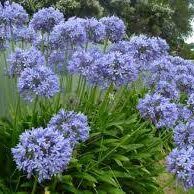Growing Agapanthus: A Full Guide to Beautiful Blooms
Growing Agapanthus: A Full Guide to Beautiful Blooms
Blog Article
Mastering the Art of Agapanthus Care: Necessary Actions for Healthy And Balanced Growth and Dynamic Blossoms
In the world of gardening, the cultivation of agapanthus stands as a fulfilling undertaking for those who seek to nurture these stylish flowering plants. From picking the best variety to understanding trimming strategies, the trip towards growing thriving agapanthus plants is diverse and holds the vital to unlocking the full potential of these herb gems.

Selecting the Right Agapanthus Variety

When choosing the appropriate Agapanthus selection for your garden, think about variables such as climate suitability, flower shade, and development habit. In addition, think about the environment in your region to make sure the Agapanthus variety you pick can thrive in your specific problems. Recognizing the growth habit of various Agapanthus selections is important for proper positioning within your garden.
Ideal Planting Problems
Thinking about the optimum ecological requirements is crucial for successful Agapanthus farming. Agapanthus plants are sensitive to cool temperature levels and ought to be secured from frost during winter season months.
To guarantee healthy and balanced growth and dynamic flowers, plant Agapanthus bulbs at a depth of about 2-4 inches and area them 8-12 inches apart. Including raw material, such as garden compost, to the soil can enhance drainage and fertility, promoting durable origin development. Mulching around the base of the plants assists maintain dampness and subdues weed development. Routine watering is essential, particularly throughout the growing period, to maintain the dirt continually wet however not soaked.
Watering and Fertilizing Tips
Preserving correct dampness levels and giving vital nutrients are essential elements in the treatment routine for Agapanthus plants. When it comes to sprinkling Agapanthus, it is essential to strike an equilibrium. These plants prefer constantly moist soil but are susceptible to root rot if overwatered.
Feeding Agapanthus is necessary for promoting healthy growth and prolific blossoms. Apply a well balanced plant food, such as a 10-10-10 formula, in the early springtime as brand-new development emerges. Repeat this application every 6-8 weeks throughout the growing period. Stay clear of excessive fertilization, as it can lead to lush vegetation at the expenditure of flowers. Constantly adhere to the supplier's guidelines for correct dilution and application approaches. By complying with these watering and fertilizing tips, you can ensure your Agapanthus plants flourish and produce dynamic, lasting blossoms.
Pruning Techniques for Agapanthus
Pruning Agapanthus plants at the proper times and with correct strategies is essential for maintaining their health and advertising optimal growth and flowering. The excellent time to prune Agapanthus is in late wintertime or very early spring before brand-new development emerges. Begin by eliminating any kind of dead or yellowing leaves near the base of the plant. Cut them as close to the ground as possible without harming the emerging shoots.
Deadheading invested blossoms can likewise redirect the plant's power into generating more blossoms instead than setting seeds. If you want to collect seeds for proliferation, leave some flowers to completely dry and fully grown on the plant.
Keep in mind to make use of clean, sharp devices to make accurate cuts and lower the danger Read More Here of presenting illness. Agapanthus. Regular trimming will certainly aid keep your Agapanthus looking check this healthy and balanced and neat while making sure a bountiful screen of gorgeous blooms
Managing Usual Insects and Illness
After making sure correct pruning methods for Agapanthus, it is necessary to deal with common insects and diseases that can influence the wellness and vigor of these plants. One typical parasite that influences Agapanthus is the Agapanthus gall midge.
An additional usual problem is fungal fallen leave spot, which provides as dark lesions on the leaves. To protect against fungal illness, make certain excellent air circulation around the plants, avoid overhanging watering, and remove any contaminated leaves without delay. Furthermore, Agapanthus plants can experience root rot if they are grown in improperly draining dirt. To avoid this, plant Agapanthus in well-draining soil and prevent overwatering. By being alert and taking prompt action versus bugs and diseases, you can aid your Agapanthus plants prosper and produce vibrant blooms.

Final Thought
In conclusion, mastering the art of agapanthus care entails choosing the appropriate range, supplying ideal growing conditions, appropriate watering and feeding, ideal trimming methods, and addressing usual pests and illness. By adhering to these essential actions, you can ensure healthy and balanced development and vivid flowers for your agapanthus plants. Remember to regularly keep track of blog here and preserve your plants to promote their overall health and longevity.
To ensure healthy growth and vibrant blooms, plant Agapanthus bulbs at a deepness of concerning 2-4 inches and area them 8-12 inches apart. By adhering to these watering and feeding suggestions, you can ensure your Agapanthus plants prosper and produce dynamic, lasting flowers.
One typical bug that influences Agapanthus is the Agapanthus gall midget. In addition, Agapanthus plants can experience from root rot if they are grown in improperly draining pipes soil. By following these crucial steps, you can guarantee healthy and balanced development and dynamic flowers for your agapanthus plants.
Report this page